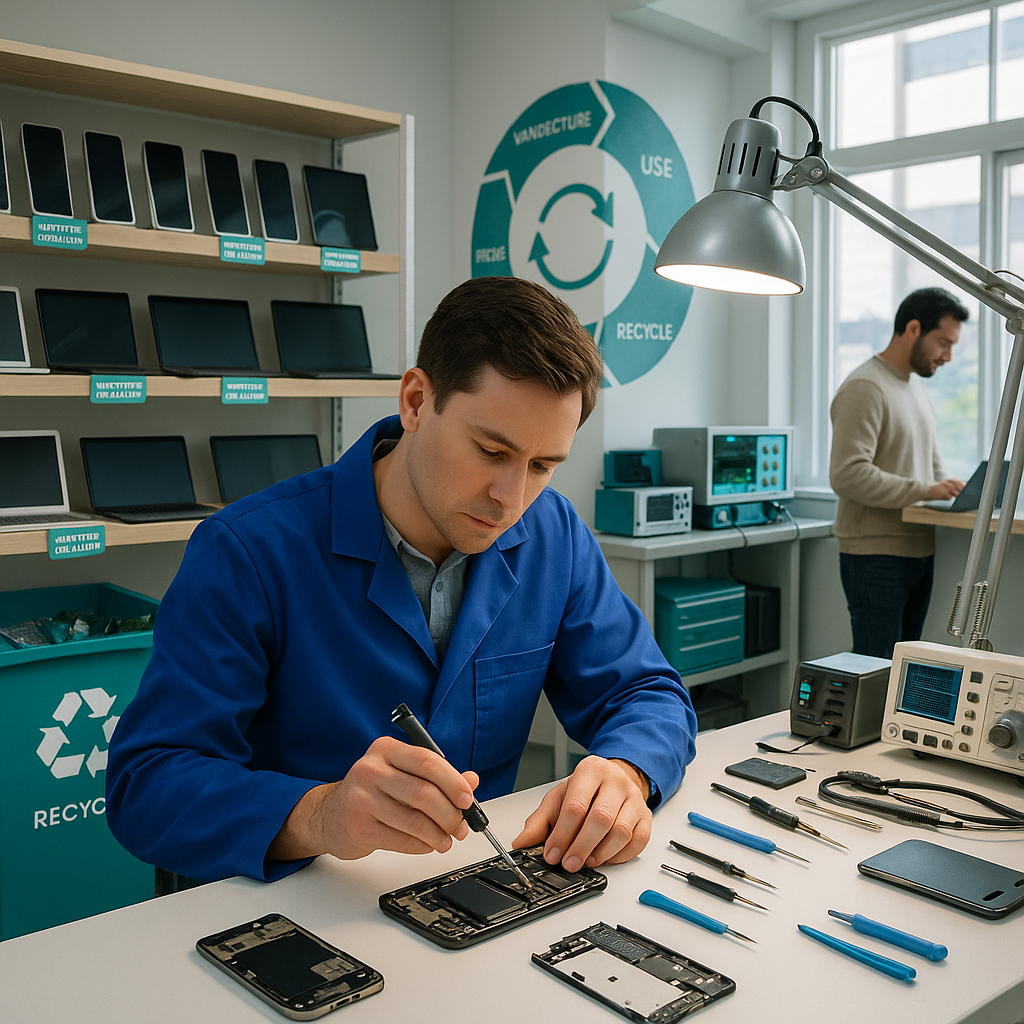Key Takeaways
- Extend device lifespans through refurbishment. Choosing refurbished gadgets helps keep electronics in use longer, reducing the need for new manufacturing and minimizing environmental footprint.
- Reduce e-waste by embracing circular tech models. A circular approach promotes repair, upgrading, and reuse of devices, significantly decreasing the amount of electronics sent to landfills.
- Refurbished does not equal inferior performance. Today’s certified refurbished gadgets undergo rigorous testing and restoration. They provide reliability and modern features at a lower cost, making them both practical and eco-friendly alternatives.
- Sustainable choices fuel industry innovation. As more consumers seek eco-conscious tech, manufacturers and retailers are driven to adopt greener practices, such as responsible material sourcing and building devices for longevity.
- Save smart while supporting sustainability. Buying refurbished products lowers both your environmental impact and your expenses, making high-quality devices more accessible to a broader audience.
- Contribute to a sustainable digital ecosystem. Embracing eco gadgets and circular tech principles fosters a cycle where tech resources are reused, conserved, and continually optimized rather than wasted.
With these takeaways in mind, the article ahead examines how circular tech is reshaping consumer behavior, combating environmental damage, and setting the stage for a more sustainable digital future.
Introduction
Every year, millions of smartphones, laptops, and other electronics become electronic waste, despite the fact that most could be refurbished or reused. Circular tech turns this challenge into an opportunity by advocating for refurbishment, reuse, and responsible recycling. Once-discarded devices get a second chance as eco-friendly gadgets.
Opting for refurbished devices is more than just a cost-saving strategy. It’s an impactful way to reduce electronic waste while still benefiting from reliable performance and modern features. As consumer demand for sustainability grows, manufacturers are responding with greener practices and products built to last.
Let’s uncover how circular tech empowers us to minimize e-waste, enhance sustainability, and create a digital future where technology and the environment can thrive together.
Un passo avanti. Sempre.
Unisciti al nostro canale Telegram per ricevere
aggiornamenti mirati, notizie selezionate e contenuti che fanno davvero la differenza.
Zero distrazioni, solo ciò che conta.
 Entra nel Canale
Entra nel Canale
Understanding the Circular Tech Economy
The circular tech economy represents a strategic shift from the standard “take-make-dispose” production model to a more eco-aware “make-use-return-reuse” approach. Here, the focus is on extending the lifespan of electronic devices by prioritizing refurbishment, recycling, and responsible disposal.
The Economic Impact of Circular Tech
The circular tech sector is experiencing rapid expansion. For example, the global market for refurbished smartphones reached $49.9 billion in 2020, and is projected to grow at an annual rate of 13.2% through 2025. Companies such as Back Market reported an impressive 400% year-over-year growth, highlighting strong consumer enthusiasm for sustainable technology.
Major technology manufacturers are also adopting circular principles across diverse industries:
- Apple’s Daisy robot can disassemble 200 iPhones per hour, reclaiming valuable materials.
- Samsung’s Galaxy Upcycling program repurposes old smartphones as Internet of Things (IoT) devices and security monitors.
- Dell has pledged to reuse or recycle an equivalent product for every unit sold by 2030, a target echoed in sectors such as healthcare and education, where device longevity and recycling are increasingly essential.
Environmental Benefits and Resource Conservation
The circular tech model offers substantial environmental advantages. Recycling one million smartphones can recover:
- 35,274 pounds of copper
- 772 pounds of silver
- 75 pounds of gold
- 33 pounds of palladium
This material recovery process helps reduce mining and conserves valuable natural resources across industries (not just consumer tech, but also in medical equipment, industrial control systems, and data center infrastructure). Refurbishing devices generates 85% fewer carbon emissions compared to manufacturing new ones. That dramatically shrinks the carbon footprint and supports sustainability in both corporate and public sectors.
Implementing Circular Tech Practices
The successful implementation of circular technology involves the adoption of best practices that extend the life and optimize the value of existing electronics.
Smart Device Management
Proper device stewardship is crucial for both individuals and organizations aiming to maximize tech lifespans and performance. Effective strategies include:
- Consistent software updates and maintenance to protect against vulnerabilities.
- Use of protective cases and screen protectors to minimize physical damage.
- Battery optimization methods, such as avoiding extreme charging cycles.
- Prompt repairs to address small issues before they become major failures.
Businesses and educational institutions applying these approaches have achieved device lifecycles that are up to 40% longer, leading to lower operational costs and reduced environmental burdens.
Prompt repairs and reuse strategies are especially effective for extending the useful life of consumer electronics, showcasing how embracing circular practices can lead to significant cost savings and sustainability gains.
Responsible Recycling and Disposal
Professional e-waste recycling is vital for mitigating environmental hazards and maximizing material recovery. Noteworthy results can be seen across multiple sectors:
- Best Buy’s recycling initiative has collected over 2 billion pounds of electronics, serving both private consumers and small businesses.
- TerraCycle’s e-waste division consistently achieves a 96% recycling rate, contributing to sustainable office and retail environments.
- The European Union’s Waste Electrical and Electronic Equipment (WEEE) directive has boosted e-waste recycling rates by 59% since 2015, influencing global movement toward responsible recycling in industries from healthcare to finance.
The Rise of Refurbished Technology
Quality Assurance in Refurbished Devices
Modern refurbishment practices have reached a level of rigor that matches new device production. This ensures high standards for performance and reliability:
- Comprehensive diagnostic testing procedures
- Detailed repairs at the component level
- Inspections by certified technicians
- Thorough performance verification and stress testing
- Availability of extended warranty options for peace of mind
For example, Back Market has reported failure rates of refurbished devices below 5%, which is on par with new products. Such reliability has made refurbished tech a compelling option for professionals, educators, and healthcare settings looking for trusted, cost-effective solutions.
Market Growth and Consumer Benefits
The market for refurbished technology presents a host of advantages:
- Savings of 30-50% compared to new models, appealing to budget-conscious consumers and organizations alike.
- Professional warranty coverage, ensuring post-purchase support.
- Reduced environmental impact, as every refurbished device is one less item destined for a landfill.
- Access to premium brands and advanced features at accessible prices.
Budget-conscious consumers and small organizations are increasingly turning to refurbished devices as a way to balance performance and sustainability without sacrificing quality.
Programs like Renewed Lab have helped consumers collectively save $12 million, while preventing 500,000 pounds of e-waste. Across sectors such as education, small business, and healthcare, the circular tech model is proving its value by balancing cost, quality, and sustainability.
Innovation in Sustainable Tech Design
Advancements in design and materials are elevating the circular tech movement and enabling more sustainable options for consumers and businesses.
Un passo avanti. Sempre.
Unisciti al nostro canale Telegram per ricevere
aggiornamenti mirati, notizie selezionate e contenuti che fanno davvero la differenza.
Zero distrazioni, solo ciò che conta.
 Entra nel Canale
Entra nel Canale
Modular Technology and Repairability
Today’s eco-conscious design philosophy centers on:
- Components that are easy to replace or upgrade
- Standardized parts for cross-compatibility
- Tool-free device access for hassle-free repairs
- Detailed repair guides (both print and digital) to empower users
Framework Laptop is a leader in this space, earning a perfect 10/10 repairability score from iFixit. Its modular design allows users from various fields (including IT, education, and even creative industries) to upgrade or repair laptops themselves, keeping devices in use and out of landfills longer.
Materials Innovation and Eco-Design
Manufacturers are investing in advanced sustainable materials to reduce environmental impact:
- Pela produces biodegradable phone cases, popular in retail and corporate gifting.
- Apple uses 100% recycled aluminum for MacBook enclosures, reducing resource extraction.
- Samsung integrates plant-based plastics into its monitors and display panels, providing greener solutions for both offices and homes.
Reducing resource extraction and material waste also makes a significant impact on energy use, further aligning with the wider sustainability goals embraced by the circular tech movement.
These efforts have contributed to a 30% reduction in virgin material usage among participating manufacturers. As sustainability becomes a business imperative, such initiatives are being adopted by entities in automotive, home appliance, and industrial control sectors as well.
Corporate Responsibility and Industry Initiatives
Manufacturer Take-Back Programs
Leading tech brands are spearheading initiatives that close the loop on device lifecycles:
- HP’s Planet Partners has recycled over 875 million printer cartridges, supplying educational, business, and public sector needs.
- Apple’s Trade In program helped offset 10.2 million devices in 2020, providing credits toward upgrades and ensuring safe disposal.
- Microsoft collected 12.8 million pounds of e-waste through ongoing collection and recycling efforts, supporting circularity in enterprise and public sector technology.
Take-back initiatives create a sustainable pathway not just in tech but also across smart home and IoT device spaces, by encouraging responsible lifecycle management.
Industry Standards and Certification
Certification programs play an essential role in assuring product quality and sustainability:
- TCO Certified ensures social and environmental responsibility throughout the IT product lifecycle.
- R2 (Responsible Recycling) certification validates best-in-class e-waste recycling processes, adopted by recycling facilities and manufacturers globally.
- e-Stewards certification sets standards for safe, ethical, and environmentally responsible electronics recycling.
Certified organizations have seen a 25% increase in responsible recycling, helping set the bar for sustainable tech across a variety of industries.
Conclusion
The evolution toward a circular tech economy is fundamentally reshaping how we design, use, and retire our electronic devices. It unlocks substantial economic, environmental, and practical benefits. Thanks to booming refurbished markets, resource recovery breakthroughs in recycling, and bold innovation in modular and sustainable design, industries are demonstrating that technological progress and environmental responsibility can advance together. Leading brands and agile startups across sectors are raising standards and putting responsible practices at the center of their strategies.
For consumers, this shift delivers greater access to affordable, reliable technology, while aligning everyday choices with long-term sustainability goals. As circular principles continue to reshape the tech landscape, participation is no longer simply a personal preference. It’s rapidly becoming an essential strategy for safeguarding devices, budgets, and the environment alike.
Reliable technology doesn’t have to come at the expense of the planet—adopting circular tech is both a smart and sustainable choice.
The future belongs to those who adapt proactively. Whether you’re an individual, a business, or a tech manufacturer, now is the time to join the movement and champion circular tech. By taking action today, you will help shape a digital world where innovation flourishes in harmony with our planet. The question is not whether to embrace circular technology, but how you will lead in making it a new standard for progress and sustainability.





Leave a Reply